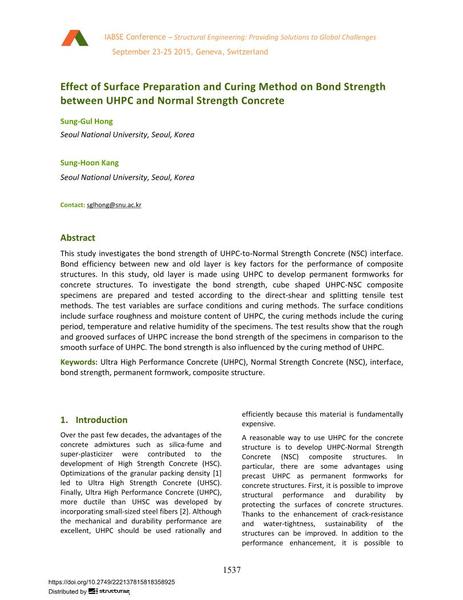Effect of Surface Preparation and Curing Method on Bond Strength between UHPC and Normal Strength Concrete

|
|
|||||||||||
Bibliografische Angaben
| Autor(en): |
Sung-Gul Hong
(Seoul National University, Seoul, Korea)
Sung-Hoon Kang (Seoul National University, Seoul, Korea) |
||||
|---|---|---|---|---|---|
| Medium: | Tagungsbeitrag | ||||
| Sprache(n): | Englisch | ||||
| Tagung: | IABSE Conference: Structural Engineering: Providing Solutions to Global Challenges, Geneva, Switzerland, September 2015 | ||||
| Veröffentlicht in: | IABSE Conference Geneva 2015 | ||||
|
|||||
| Seite(n): | 1537-1543 | ||||
| Anzahl der Seiten (im PDF): | 7 | ||||
| Jahr: | 2015 | ||||
| DOI: | 10.2749/222137815818358925 | ||||
| Abstrakt: |
This study investigates the bond strength of UHPC-to-Normal Strength Concrete (NSC) interface. Bond efficiency between new and old layer is key factors for the performance of composite structures. In this study, old layer is made using UHPC to develop permanent formworks for concrete structures. To investigate the bond strength, cube shaped UHPC-NSC composite specimens are prepared and tested according to the direct-shear and splitting tensile test methods. The test variables are surface conditions and curing methods. The surface conditions include surface roughness and moisture content of UHPC, the curing methods include the curing period, temperature and relative humidity of the specimens. The test results show that the rough and grooved surfaces of UHPC increase the bond strength of the specimens in comparison to the smooth surface of UHPC. The bond strength is also influenced by the curing method of UHPC. |
||||
| Stichwörter: |
Verbundkonstruktion
|
||||
